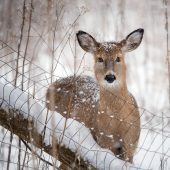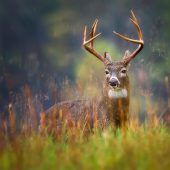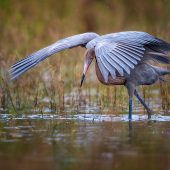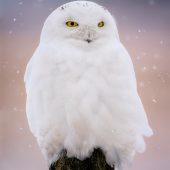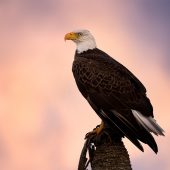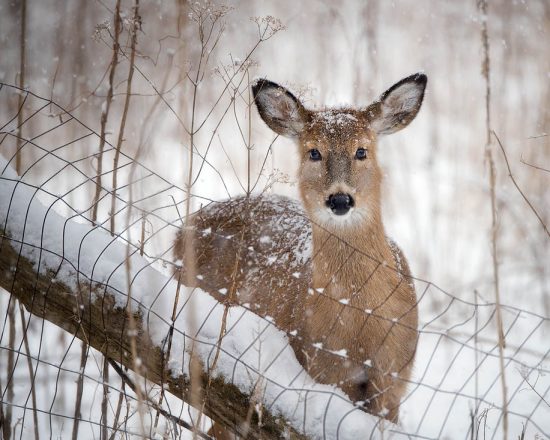“Nikon DX camera vs. cropping or putting a teleconverter on a full frame body” is a new article by Steve Perry (website | YouTube | Facebook). You can check also his previous [NR] posts here:
Have you ever attempted to bag a prize wildlife photo only to discover that you needed a little more “reach” than what the lens hanging off the front of your camera was delivering? As a wildlife shooter, I tend to get into head-on collisions with that scenario on a regular basis – especially with my full frame bodies.
Well, along about the time the D300 and D3 came out, I began experimenting with and comparing crop bodies to full frame bodies (with and without TCs). And along the way, I realized that sometimes the right photographic tool for the job might not be what you had previously thought.
With the introduction of the D500, questions of when to use a crop camera or when to use a full frame camera have become as common as mosquitoes in a tent. Each day, my inbox sees a variety of crop vs. full frame camera conundrums, and it usually boils down to one of the two questions below.
- Is it better to crop an FX camera to the DX area – or just use a dedicated DX camera?
- Is it better to use an FX camera with a 1.4 teleconverter or switch to a DX camera?
In fact, I was getting these questions so frequently I decided it was about time to make a couple of videos to address those scenarios.
In this first video, we’ll look at the difference between cropping a D5 and D810 to the same (DX) field of view we get with a D500. Will the full frame cameras have what it takes to kick the crop camera to the curb? Click play to find out 🙂
In this next video, we’ll look at an even more common question:
Are you better off using a full frame camera with a 1.4x teleconverter or just switching to a crop camera?
In this one, we’ll look at some sharpness comparisons with a 1.4 TCE III teleconverter hitched to a D5 and D810 vs. the naked lens on a D500. We’ll also look at three additional pitfalls that anyone using a teleconverter needs to be aware of before they strap one on.
My field results certainly mimic what the tests in the videos show. So, hopefully, these videos can help provide a guideline that allows you to have an edge the next time you’re debating which camera, lens, and teleconverter combo you should employ to capture your next critter (or athlete, race car, etc.).
Also, keep in mind that you should think of these videos as a series of general guidelines and not immutable laws that absolutely apply to every setup and situation across the board. There are always exceptions. I encourage you to experiment with your own gear and choose the combinations that give you the highest keeper rate.
Next, let’s take a look at a few quick sample images and why I chose the equipment setups I did.
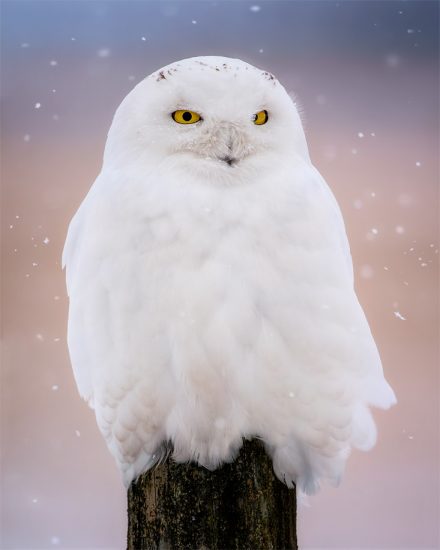
Ghost Of The North (Nikon D7200, Nikon 600mm F4, 1/1600th, ISO 720, F4)
I was geeking out on Snowy Owls earlier this year when I spotted this guy on a fence post. There were quite a few owls in the area, and some were more approachable than others. As I eagerly drove towards him, it seemed like he was one of the tolerant ones. Naturally, he was on the wrong side of the truck (I can’t shoot out of the passenger window due to a chronic lack of coordination), so I slowly eased past him and parked a little bit up the road.
I knew for the shot I wanted, I would need to be closer than even this seemingly patient owl would likely allow on foot, so getting out of the truck seemed like a bad idea. Plus, the Jeep hadn’t seemed to bother him at all as it passed. So, I removed my D4 and 600mm lens from the tripod in the back of the truck and attached the lens to my D7200.
Now, I could have chosen to try the same shot with the D4 (or now the D5). However, I’d have to be 1.5X closer than what was needed with the D7200. He was tolerant, but not stupid. I knew that if I were to get into FX range there was a good chance he would show me his tail feathers as soon as I poked my lens out of the window. With the D7200, I was able to stay on the far side of the road (which, as you can see, was fine by him).
I also could have used the teleconverter with the D4, but the truth is, I knew I would capture much more detail with the D7200 than the D4 + TC combo. Since I didn’t need the quick FPS of the D4, this was a no-brainer.
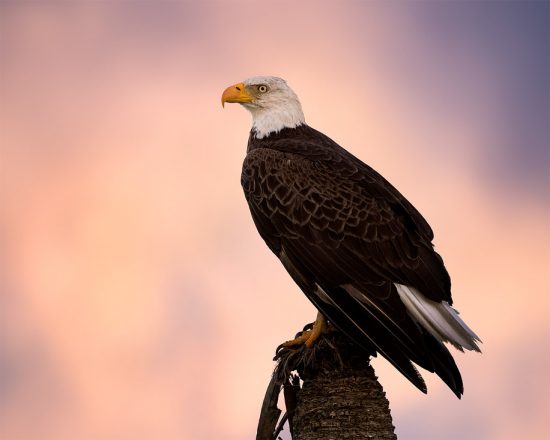
Eagle At Sunset (Nikon D500, Nikon 600mm F4 + 1.4TCE III, 1/1600th, ISO 3600, F6.3)
After watching the second video above, you may be under the impression that I completely shun any use of a teleconverter, but I wanted to include this photo to show that’s really not the case.
While I do try to avoid teleconverters when possible, I certainly won’t pass by an opportunity due to some sort of TC-phobia. I still keep my 1.4TC with me regardless of which camera I have at the moment. In this case, I used the teleconverter on the D500 in order to get enough “reach” to capture this eagle. This was definitely out of range for my D5 (at least with my lenses), but the D500’s high pixel density put enough pixels on the eagle for a nice shot.
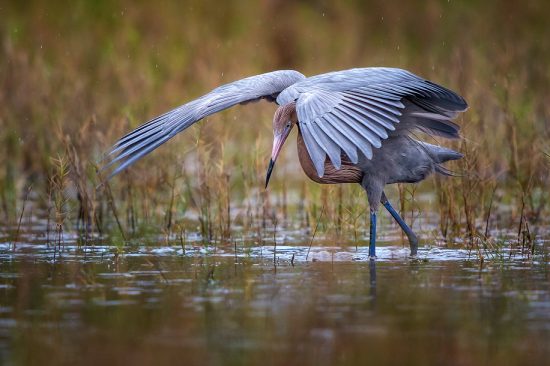
Reddish Egret Hunting (Nikon D7200, Nikon 600mm F4, 1/1000th, ISO 900, F4.5)
Here’s another example of where I opted for the crop camera (a D7200 in this case) over a full frame camera.
If you’ve ever watched a Reddish Egret hunt, you know they are absolutely crazy. They run around the tidal pools dashing unpredictably from spot to spot confusing the little fish into becoming an appetizer.
In this case, I had a D4 and D7200 in the bag and decided to go for the D7200. Not only was it capturing more detail, but in my opinion, the AF on the D7200 is slightly better than the D4 when it is shacked with a teleconverter.
So, while I wouldn’t have minded the faster frame rate of the D4, overall I decided that the D7200 brought a little more to the table on this shot. (That, and noise performance is pretty close once you add the TC to the D4 and compensate with another stop of ISO.)
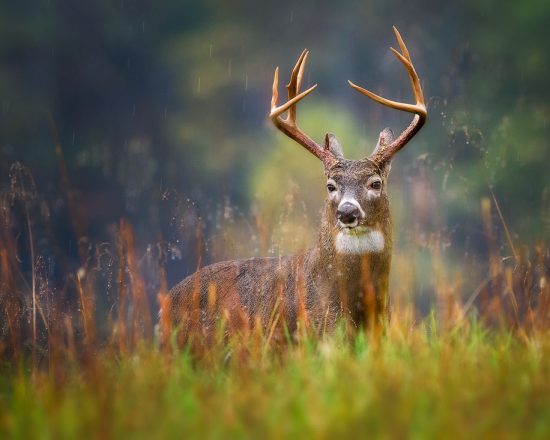
Buck In The Rain (Nikon D7200, Nikon 600mm F4, 1/180th, ISO 1400, F4)
I found this big guy in the Smoky Mountains last fall during an all-day rain. He was further out than I would have liked and my calling him over didn’t seem to encourage him to get any closer (although it did make a few people step back to their cars). So I knew that it was, once again, the choice between the D7200, the D4 cropped, or the D4 + TC.
Since cropping the D4 to D7200 size would result in about a 7MP file vs. the 24MP from the D7200, that part of the choice was pretty easy. Even on a D5, it would only have been 9MP.
Of course, I could have used a teleconverter on the D4, but then I still have lower resolution plus a small optical penalty from the teleconverter. So, the D7200 got the nod.
A Doe On A Snowy Morning (Nikon D810, Nikon 80-400, 1/250th, ISO 720, F5.6)
Of course, there are times the full frame camera gets the call, such as the shot we have here.
In this case, I was out with the D810 and the 80-400. The deer in my local park are relatively approachable, so I knew that I could use an FX camera with little or no cropping. So, picking full frame was an easy choice.
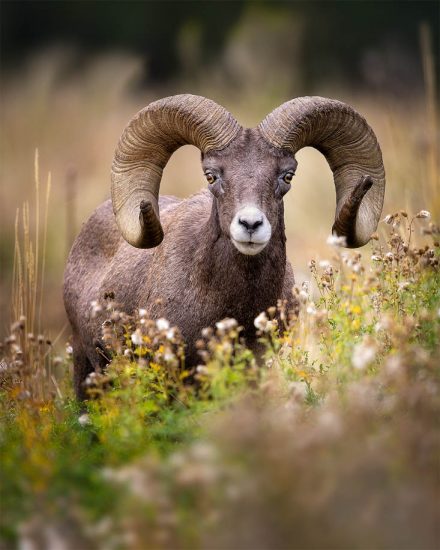
Bighorn Ram (Nikon D5, Nikon 600mm F4, 1/1250th, ISO 640, F4)
Once again, another nod to full frame. This time, I could have gone with the D500 or the D5. Since he was in easy range of the D5 and 600mm, I went that route. I really love those creamy backgrounds, and a full frame camera with a big, fast lens is my favorite way to get there. Plus, at ISO 640 there’s absolutely no sign of noise in this image.
Final Thoughts…
In the end, I ALWAYS try to use a full frame camera when I can – there are just too many advantages not to.
However, if I need to add a teleconverter or do a heavy crop, then most or all of the advantages of full frame are diminished – or disappear altogether. When that happens, I prefer to switch to a crop camera as I discussed in the videos.
Oh, and don’t get me wrong – you can get great shots with whatever camera you happen to have. I’ve had images published that were taken with crop cameras, full frame cameras, full frame cameras that were cropped, and cameras with teleconverters attached. Remember, in many cases the differences are minor. However, if you have the option of using FX or DX, hopefully these videos will help make the decision of which camera to pull out of the bag a little easier.
Finally, if you enjoy these videos, make sure to stop by my site and check out my e-book, Secrets To Stunning Wildlife Photography. It’s nearly 300 pages of my best tips tricks, and advice for getting award-winning images on your memory card.
If you have an interesting idea for a guest post, you can contact me here.

